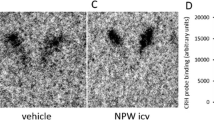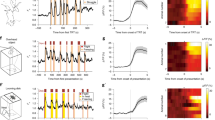Abstract
Neuropeptide W (NPW) was isolated and found to be an endogenous peptide ligand for the orphan receptors GPR7 and GPR8. Centrally administered NPW caused a dose-dependent increase in corticosterone levels in rats. This observation indicates that NPW may play an important role in the hypothalamic organization of the endocrine response to stress. We examined the effects of immobilization stress and cold exposure on NPW-containing neurons in the hypothalamus of the rat, using dual immunostaining for NPW and Fos. In addition, to analyze the function of NPW, we studied the effect of intracerebroventricular (icv) NPW administration on Fos protein accumulation in the brain. Double immunohistochemistry for NPW and Fos showed that the percentage of Fos expression in the NPW-immunoreactive cells of the perifornical nucleus was significantly increased by immobilization stress compared with that in nonstressed rats. Similarly, the results indicated that cold exposure activates NPW-immunoreactive neurons in the perifornical nucleus. An icv administration of NPW resulted in significant Fos expression in the paraventricular nucleus, as compared with saline-infused controls. These results suggest that NPW is related to stress-responsive signal transduction, and that NPW may modulate the hypothalamus-pituitary-adrenal axis.
Similar content being viewed by others
References
Shimomura, Y., Harada, M., Goto, M., et al. (2002). J. Biol. Chem. 277, 35826–35832.
Brezillon, S., Lannoy, V., Franssen, J. D., et al. (2003). J. Biol. Chem. 278, 776–783.
Tanaka, H., Yoshida, T., Miyamoto, N., et al. (2003). Proc. Natl. Acad. Sci. USA 100, 6251–6256.
Dun, S. L., Brailoiu, G. C., Yang, J., Chang, J. K., and Dun, N. J. (2003). Neurosci. Lett. 349, 71–74.
O’Dowd, B. F., Scheideler, M. A., Nguyen, T., et al. (1995). Genomics 28, 84–91.
Lee, D. K., Nguyen, T., Porter, C. A., Cheng, R., George, S. R., and O’Dowd, B. F. (1999). Mol. Brain Res. 71, 96–103.
Baker, J. R., Cardinal, K., Bober, C., Taylor, M. M., and Samson, W. K. (2003). Endocrinology 144, 2816–2821.
Fisher, L. A. (1989). Trends Pharmacol. Sci. 10, 189–193.
Ida, T., Nakahara, K., Murakami, T., Hanada, R., Nakazato, M., and Murakami, N. (2000). Biochem. Biophys. Res. Commun. 270, 318–323.
Pan, B., Castro-Lopez, J. M., and Coimbra, A. (1997). Neuroscience 78, 1059–1068.
McCarty, R. (1985). J. Auton. Nerv. Syst. 12, 115–122.
Taylor, M. M., Yuill, E. A., Baker, J. R., Ferri, C. C., Ferguson, A. V., and Samson, W. K. (2004). Am. J. Physiol. Regul. Integr. Comp. Physiol. 288, R270-R275.
Niimi, M., Sato, M., Yokote, R., Tada, S., and Takahara, J. (1999). J. Neuroendocrinol. 11, 605–611.
Niimi, M., Murao, K., and Taminato, T. (2001). Endocrine 14, 269–273.
Author information
Authors and Affiliations
Corresponding author
Rights and permissions
About this article
Cite this article
Niimi, M., Murao, K. Neuropeptide W as a stress mediator in the hypothalamus. Endocr 27, 51–54 (2005). https://doi.org/10.1385/ENDO:27:1:051
Received:
Revised:
Accepted:
Issue Date:
DOI: https://doi.org/10.1385/ENDO:27:1:051




